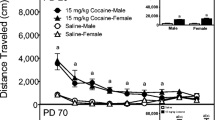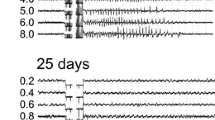Abstract
Developing rats are far more sensitive than adults to the behavioral effects of haloperidol. The present results support the hypothesis that this change may reflect age-related changes in brain responses such as alterations in drug-receptor or drug-effector mechanisms. Dose-response studies of catalepsy and ptosis were conducted in male Sprague-Dawley rats aged 30, 56, or 100 days. Resulting dose-effect curves were approximately parallel and showed rightward shifts with highly significant progressive increases of ED50. Similar developmental decreases in drug sensitivity (3–6 ×) were found following systemic (PO or IP) administration of haloperidol or the phenothiazine neuroleptic perphenazine, which differ markedly in structure, potency, distribution, and metabolism. Age-related decreases in drug sensitivity (3–4 ×) were also found using intracerebroventricular (ICV) administration of both agents in an attempt to bypass potential “pharmacokinetic” influences. Since the age-dependent decrease in sensitivity to both neuroleptics was found during the rising phase of drug action (1st hour) and ranked: PO>IP>ICV, some change in absorption and distribution of both drugs may occur in addition to the apparently important maturational decrease in target-organ sensitivity indicated by the responses to direct ICV injection and by the similarity of results obtained with dissimilar agents.
Similar content being viewed by others
References
Baldessarini RJ (1985) Chemotherapy in psychiatry: principles and practice. Harvard University Press, Cambridge, pp 14–92
Brakkee JH, Wiegant VM, Gispen WH (1979) A simple technique for rapid implantation of a permanent cannula into the rat brain ventricular system. Lab Anim Sci 29:78–81
Brus R, Krzeminski T, Pigula J (1983) Cataleptogenic effect of haloperidol, chlorpromazine, and morphine in developing rats. Pol J Pharmacol Pharm 35:377–382
Campbell A, Baldessarini RJ (1981a) Effects of maturation and aging on behavioral responses to haloperidol in the rat. Psychopharmacology 73:219–222
Campbell A, Baldessarini RJ (1981b) Tolerance to behavioral effects of haloperidol. Life Sci 29:1341–1346
Campbell A, Baldessarini RJ, Stoll A, Teicher MH, Maynard P (1984) Effect of age on behavioral responses and tissue levels of apomorphine in the rat. Neuropharmacology 23:725–730
Campbell A, Baldessarini RJ, Teicher MH, Neumeyer JL (1985) S(+)apomorphines: Selective inhibition of excitatory effects of dopamine injected into the limbic system of the rat. Neuropharmacology 21:391–399
Cheronis JC, Erinoff L, Heller A, Hoffmann PC (1979) Pharmacological analysis of the functional ontogeny of the nigrostriatal dopaminergic neurons. Brain Res 169:545–560
Coyle JT, Compochiaro P (1976) Ontogenesis of dopaminergic-cholinergic interaction in the rat striatum: A neurochemical study. J Neurochem 27:673–678
Coyle S, Napier TC, Breese GR (1985) Ontogeny of tolerance to haloperidol: Behavioral and biochemical measures. Dev Brain Res 23:27–38
DeLean A, Munson PG, Rodbard D (1978) Simultaneous analysis of families of sigmoid curves: Application to bioassay, radioligand assay, and physiological dose-response curves. Am J Physiol 4:E97-E102
Forrest IS, Carr CJ, Usdin E (eds) (1974) Phenothiazines and related compounds. Raven, New York, p 818
Kapetanovic IM, Sweeney DJ, Rapoport SI (1982) Age effects on haloperidol pharmacokinetics in male Fischer-344 rats. J Pharmacol Exp Ther 221:434–438
Keepers GA, Clappison VJ, Casey DE (1983) Initial anticholinergic prophylaxis for acute neuroleptic induced extrapyramidal syndromes. Arch Gen Psychiatry 40:1113–1117
Lewi PJ, Heykants JJ, Allewijn FT, Dony JG, Janssen PA (1970) Distribution and metabolism of neuroleptic drugs. Arzneimittelforschung 20:943–948
Meyer ME, Smith RL, Van Hartesveldt C (1984) Haloperidol differentially potentiates tonic immobility, the dorsal immobility response, and catalepsy in the developing rat. Dev Psychobiol 17:383–389
Murrin LC, Zeng W (1986) Postnatal ontogeny of dopamine D-2 receptors in rat striatum. Biochem Pharmacol 35:1159–1162
Murrin LC, Gibbens DL, Ferrer JR (1985) Ontogeny of dopamine, serotonin, and spirodecanone receptors in rat forebrain — an autoradiographic study. Dev Brain Res 23:91–109
O'Boyle KM, Waddington JL (1986) A reevaluation of changes in rat striatal D-2 dopamine receptors during development and aging. Neurobiol Aging 7:265–267
Pellegrino LJ, Cushman AJ (1967) A stereotaxic atlas of the rat brain. Meredith, New York, pp 10–25
Pizzolato G, Soncrant TT, Holloway HW, Rapoport SI (1985) Reduced metabolic response of the aged rat brain to haloperidol. J Neurosci 5:2831–2838
Stoll AL, Baldessarini RJ, Cohen BM, Finklestein SP (1984) Assay of plasma thioridazine and metabolites by high-performance liquid chromatography with amperometric detection. J Chromatogr Biomed Appl 307:457–463
Sunderland T, Cohen BM (1987) Blood to brain distribution of neuroleptics. Psychiatry Res 20:299–305
Teicher MH (1983) MED-65 ALLFIT, GRAFIT (Applesoft): Conversion of the iterative non-linear least-squares logistic dose-response analysis programs of P.J. Munson, A. DeLean, and D. Rodbard to the Apple II computer, with addition of a new graphics package. Biomedical Computing Technology Information Center, Vanderbilt University, Nashville, TN
Teicher MH, Baldessarini RJ (1987) Developmental pharmacodynamics. In: Popper C (ed) Developmental pharmacosciences of children and adolescents. Washington, APA Press, pp 45–80
Author information
Authors and Affiliations
Rights and permissions
About this article
Cite this article
Campbell, A., Baldessarini, R.J. & Teicher, M.H. Decreasing sensitivity to neuroleptic agents in developing rats; evidence for a pharmacodynamic factor. Psychopharmacology 94, 46–51 (1988). https://doi.org/10.1007/BF00735879
Received:
Revised:
Issue Date:
DOI: https://doi.org/10.1007/BF00735879




